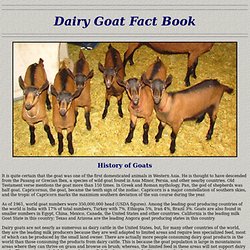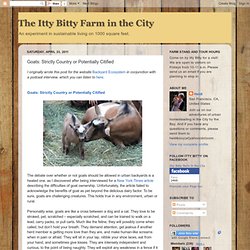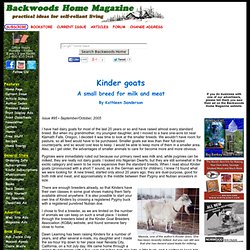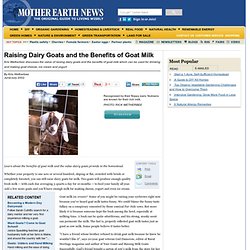

"Dairy Goats: Anchoring Your Homestead with Personality and Ice Cream" by Sheri Dixon page one. "Economics of Dairy Goats" by Allena Jackson page one. Milk prices have certainly gotten higher in the last few years, high enough that many of us small farmers are seriously considering a dairy animal.

"Goats: The Diversified Farm Stock" by Regina Anneler page one. Anyone who has started or managed a homestead knows the many hours spent trying to decide what type of livestock that they want to invest their time, money and energy into producing.

This means that each species and breed type must be considered for their usefulness and productivity as related to the current homesteading plans. Versatility in a species is a very important part of production, and one of the most versatile species chosen each and every day for the farming homestead is the goat. The goat can offer more for the dollar than nearly any other animal ever raised. Goats come in many shapes, types and colors, while being easier and cheaper to manage than cattle or other, larger types of livestock. Raising Goats For Milk - Simple and Profitable Way to Start Goat Farming - Country Farmer.
Raising goats for milk is a simple and profitable way to start an animal farm.

If you have enough number of goats, you may sell their milk for a certain price or turn them into cheese. Even better, raising goats for milk is not that hard. All you need are basic animal farming knowledge and you're good to go. Dairy Goat Handbook. History of Goats It is quite certain that the goat was one of the first domesticated animals in Western Asia.

He is thought to have descended from the Pasang or Grecian Ibex, a species of wild goat found in Asia Minor, Persia, and other nearby countries. Old Testament verse mentions the goat more than 150 times. In Greek and Roman mythology, Pan, the god of shepherds was half goat. Capricornus, the goat, became the tenth sign of the zodiac. As of 1961, world goat numbers were 350,000,000 head (USDA figures).
Dairy goats are not nearly as numerous as dairy cattle in the United States, but, for many other countries of the world, they are the leading milk producers because they are well adapted to limited areas and require less specialized feed, most of which can be produced by the small land owner. Goats: Strictly Country or Potentially Citified. I originally wrote this post for the website Backyard Ecosystemin conjunction with a podcast interview, which you can listen to here.

The debate over whether or not goats should be allowed in urban backyards is a heated one, as I discovered after being interviewed for a New York Times article describing the difficulties of goat ownership. Unfortunately, the article failed to acknowledge the benefits of goat as pet beyond the delicious dairy factor. The Benefits of Raising Goats - Dummies. You get a lot from keeping goats.

Raising goats can help you achieve a sustainable lifestyle. What does it cost to raise dairy goats? There's been a lot of interest in the dairy goat industry over the past year.

I get many calls asking about dairy goats: how much land it takes to raise them, what to feed them, and how to manage them. The one question I get asked very rarely is: how much does it cost? There is a difference between costs on a hobby operation (10 does) and a commercial operation (100 does). The scenario for this article represents a hobby operation with 10 milking does.
The total cost per doe per year is $1,024. Let's look at possible income sources for a 10-goat dairy operation. Animal sales. Kinder goats: A small breed for milk and meat by Kathleen Sanderson. I have had dairy goats for most of the last 20 years or so and have raised almost every standard breed.

But when my grandmother, my youngest daughter, and I moved to a bare one-acre lot near Klamath Falls, Oregon, I decided it was time to look at the smaller breeds. We wouldn't have room for pasture, so all feed would have to be purchased. Smaller goats eat less than their full-sized counterparts, and so would cost less to keep. I would be able to keep more of them in a smaller area. Also, as I get older, the advantages of smaller animals to care for become more and more obvious. Pygmies were immediately ruled out because our primary need was milk and, while pygmies can be milked, they are really not dairy goats. There are enough breeders already, so that Kinders have their own classes in some goat shows making them fairly available almost anywhere.
I chose to find a breeder, as we are limited on the number of animals we can keep on such a small place. However, I learned my lesson. Raising Dairy Goats for Milk. Milking goats is time consuming, so before purchasing dairy goats it’s good to know what you’re getting into.

For good-quality production, dairy goats should be milked twice per day, 12 hours apart. The milking activity will take 12 to 15 minutes per doe, plus milk preparation time. To prepare a goat for milking, you need to clean the teat with a dry paper towel to remove loose dry dirt and feces, dip the teat in an antiseptic-based teat dip, allow the dip to stay on the teats for no less than three minutes, and dry each teat following the dip with a clean paper towel. Next, look for lumps and clumps in the milk by stripping three squirts from each teat into a strip cup.
Do a strip test to check for abnormalities in the milk. Want Milk? Get Goats - Sustainable Farming. Learn about the benefits of goat milk and the value dairy goats provide to the homestead.
